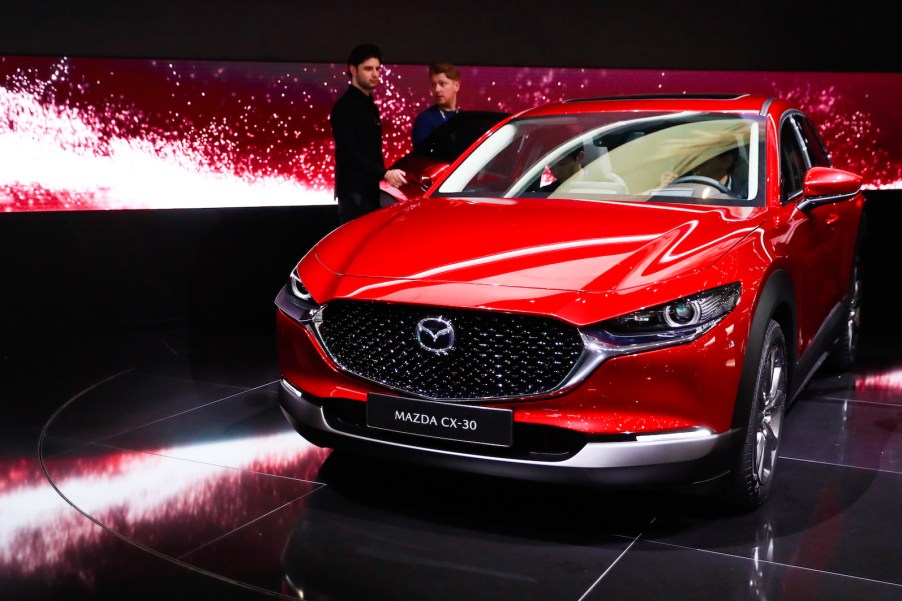
Buying a 2020 Mazda CX-30 Doesn’t Make Sense for Most People
The 2020 model year brought with it several brand-new SUV models, each with varying levels of fanfare. There’s the Lincoln Corsair, the Tesla Model Y, the white-hot Kia Telluride, and the 2020 Mazda CX-30. The Mazda is particularly intriguing because the brand has recently won several awards, including U.S. News‘ “Best Car Brand” — for the fifth straight year.
The Mazda CX-30 has a surprisingly luxurious interior and excellent safety ratings, plus a number of standard advanced safety features, but it still isn’t a sensible buy. At least not this year.
New is not necessarily better
The 2020 Mazda CX-30 joins the brand’s already-plentiful lineup of SUVs, which includes the CX-3, CX-5, and the CX-9. While each of them is a five-year-plus veteran with numerous awards and accolades, a brand-new model is not guaranteed to have the same success. Take the Lincoln Blackwood and Chevrolet SSR, for instance. These are just two examples of vehicle flops that were put out by powerhouse automakers, and there are many others.
To be clear, a newly introduced model like the 2020 Mazda CX-30 isn’t destined to be a failure. It’s also not likely to be the best version of itself, however. Many experts agree that it’s best to wait until a vehicle is in its second year — at least. Not only will this ensure that any kinks are worked out, but you may also benefit from getting newly-available features or enhancements.
As Autotrader explains, “Perhaps the best argument for skipping a first-year car is that drivers who choose such a vehicle may miss out on improvements that come later. An automaker may realize a gear lever feels better with a different knob and tightened shift action, for example. Or a missed feature may be quickly added after the first model year.”
Does size really matter?
In the case of the 2020 Mazda CX-30 specifically, car shoppers are better off waiting a year or two not just because it’s a new model, but also because it isn’t vastly different from some of Mazda’s existing crossovers. The CX-30 slots in between the (very) slightly smaller CX-3 and the CX-5, which again is only very slightly bigger.
MotorTrend did a side-by-side comparison of all three vehicles, and the numbers are surprising. While the vehicles’ overall length increases slightly from model to model (the CX-3 is 168.3 inches, the CX-30 is 173 inches, and the CX-5 is 179.1 inches long), the passenger room varies more significantly — but not in the way you would expect.
The CX-3, the smallest of the three, has 41.7 inches of legroom in the front seats. The Mazda CX-30 has that same 41.7 inches of room up front, while the CX-5 — over 10 inches longer than the CX-3 — has just 41 inches. Unsurprisingly, Consumer Reports called the CX-30’s interior “tight quarters.”
Cargo capacity varies in a more sensible way. The CX-3 has 44.5 cubic feet, the CX-30 has 45.2, and the CX-5 has 59.6. Unless for some reason you are dead-set on the exact specs of the 2020 CX-30, it makes more sense to save a bit of money and opt for a CX-3 or spend a little more on the CX-5 to get the extra space.
Committed to the 2020 Mazda CX-30?
If you have decided firmly on the 2020 CX-30, there are plenty of things to love about it. The CX-30 comes standard with many driver-assist features, its luxurious interior will surprise the most discerning shoppers, and it was named an IIHS 2020 Top Safety Pick.
Shoppers seriously considering the 2020 Mazda CX-30 should know it doesn’t come with a touchscreen. The 8.8-inch infotainment screen comes with several features including Apple CarPlay and Android Auto integration, but no touch functionality. It’s not an oversight; Mazda announced in 2019 that all future vehicles would be touchscreen-less in an effort to eliminate driver distractions. While we applaud the commitment to safety, this may be the deciding factor for some between the CX-30 and another model.


